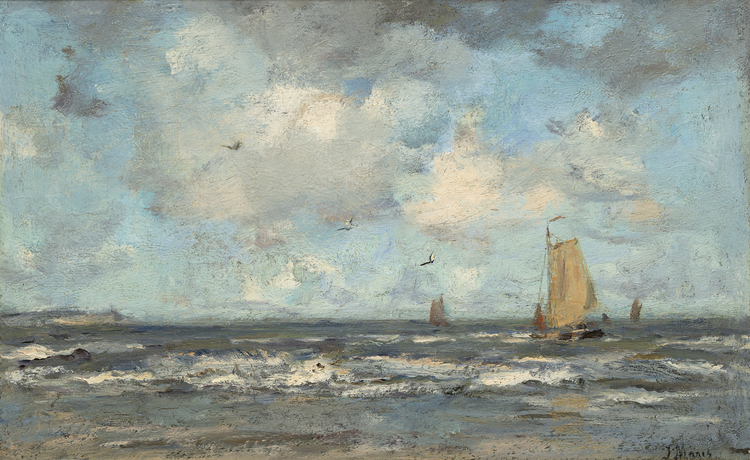J.H. (JACOB) MARIS 1837 Den Haag (The Netherlands) - 1899 Karlsbad (Czechia) Blue Sea
Oil / Canvas: 31,8 x 49,3 cm
- This artwork can be viewed in our gallery
- Call us for more information: +31 26 361 1876
- World wide shipping available
Details
In this work, Jacob Maris painted the sea and the clouds in broad, visible brush strokes, which were characteristic for his later work. We see the traces of the hair of his brush. Using his own characteristic impasto, he modelled the paint to evoke the idea of the wind blowing the clouds along through the blue sky, the breaking waves bursting onto the beach and the boat seemingly moving across the painting. The use of colour is limited to gradations of silver-grey, ochre and blue, with the latter colour setting the scene. See the painting’s title. With his masterful capacity to capture light and atmosphere, Maris became one of the most important masters of a new art movement arising around 1875: The Hague School. His paintings had already become well-loved and appreciated in Great Britain and the United Sates during his life.
Width: 49,3 cm
Kunsthandel A. Scheen, The Hague
Kunsthandel Borzo, Den Bosch
Private collection The Netherlands, 1936
Over J.H. (JACOB) MARIS
Jacob Maris was one of the founders and the most important artists of the Hague School. He was born in an artistic family, as the oldest of three brothers. His brothers Willem and Matthijs also became famous painters. As a child, Jacob already had art lessons and attended the Hague Drawing Academy [de Haagse Teekenacademie] when he was 13. When he was 15 he was discovered by the artist Huib van Hove. He followed him to Antwerp where he studied at the Antwerp Academy. Back in The Hague, he shared a studio with his brother Matthijs. An order placed by the Royal House enabled him financially to spend a while in Oosterbeek, ‘the Dutch Barbizon’ together with his brother. They also made a trip through Europe together, and visited Barbizon, where the French artists learned to paint outside.
In 1865 Jacob settled in Paris, where he earned a good income depicting smooth-painted Italian farm girls. These ‘Italiennes’ were a popular genre at the time and were very sought after by art collectors. They were sold in the Netherlands and abroad by the Parisian art trader Goupil. However, Maris was still primarily interested in landscapes, an interest that was reinforced by the genre’s ever-growing in popularity in France.
After the French-German war and the subsequent Parisian Commune, Jacob returned to the quiet city of The Hague. There he became one of the most important artists of The Hague School, which arose in the seventies of that century. Jacob Maris became famous as a painter of Dutch landscapes and cityscapes, not in the least due to his brilliant cloud-filled skies. His fame was initially at its height in Great Britain, where there was a long-standing tradition of landscape painting and where Ruysdael was wildly admired. After 1880 Maris was also one of the best-selling artists in the Netherlands; his works were highly sought after and demanded high prices.


